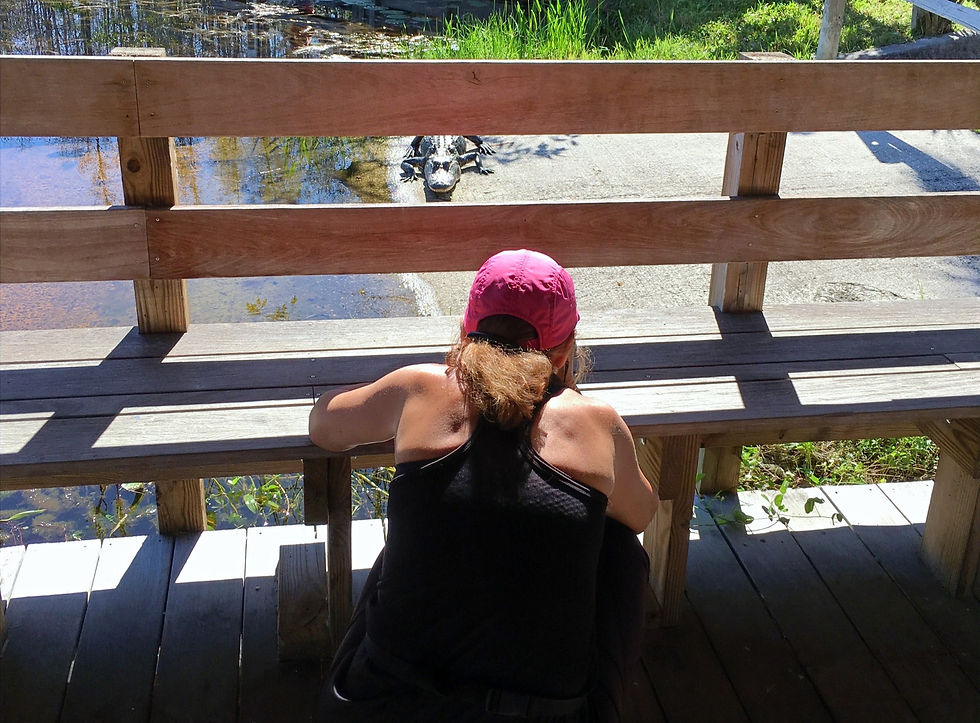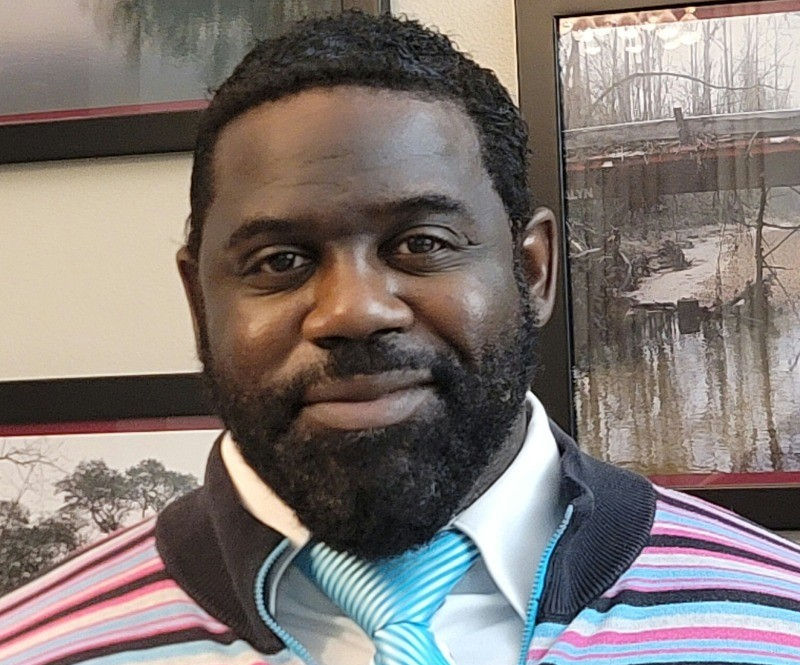Cold snaps bring out alligators — and their space invaders: 'Most of the time people get too close.'
- Jan 28, 2022
- 5 min read
Updated: Jan 29, 2022

THE GATOR WAS doing what authentic non-football Florida gators do when cold snaps force them out of the water in search of a warm sunbathing spot on land.
Nearly 9 feet long, with a spiked black body and curled tail, it was basking in the January sun on a grassy canal bank at Palmetto Trailhead Park in West Palm Beach, a true lounge lizard if there ever was one, minding its own business.
Then came the space invaders.
A young couple who’d been standing on the opposite bank about 40 feet away decided to walk around to the alligator side of the canal for a closer look.
As they closed in on the animal from behind, about 20 feet away, the alligator raised its snout, opened its jaws slightly. The man and woman slowed but resumed approaching when the reptile lowered its snout to the grass.
They got within 5 feet of the alligator’s curled tail and stopped. For what felt like a long minute, they took a few smartphone photos, then walked away.
The next day, a photograph of the couple’s close encounter with the gator was texted to a couple of respected state wildlife trappers, along with a nagging question.
Is this a good idea?

“Oh Noooo… 😳 ’’ replied Ray Simonsen, a gator expert known as Ray the Trapper.
“That close to a 🐊 is very dangerous,’’ replied Robb Upthegrove, whose Florida pioneer family has worked with alligators for 70 years.
The Florida Fish and Wildlife Conservation Commission offers an abundance of information and tips about “living with alligators,” including what should be considered an obvious one — keeping “a safe distance” from an animal considered an apex predator.

But the agency doesn’t define a “safe distance,’’ essentially leaving it to an individual’s personal discretion. And while standing within 5 feet of a lounging alligator may seem for some people like a safe thing to do, it’s not.
“This is an apex dinosaur. You don't know the temperament of that gator. He can feel he's under attack and lunge at you,’’ said Upthegrove, adding that gators can lunge 4 to 5 feet in an instant.
“People want to keep their distance. I wouldn't recommend anybody going within 25 feet of an alligator. That’s a good distance to observe and take pictures of them.’’

Simonsen recommends at least 25 feet, too.
“It's one of those things where it’s just pure common sense,'' he said.
"But I’ve heard too many stories where people go on these trails and the gator or gators are just lying there. And they’ll crouch down a few feet from an animal and they want to take a selfie,'' he said.
“Now you got your backside to a wild animal and you’ve just encroached on its space. They're not doing anything malicious. If anything he’s like, ‘Hey, get out of my zone, man.’ It's unfortunate because then the animal is the one that pays the ultimate price.’’
Alligators larger than 4 feet are trapped and euthanized if they’re considered a nuisance or have attacked a human or pet. But the gators encountered on land during cold snaps aren’t out to bother anyone.
“They’re Floridians. They're a cold-blooded creature and they're trying to get warm,’’ said Upthegrove, who like Simonsen is a licensed nuisance alligator trapper for the FWC.


Alligators are typically more visible in winter because they are ectothermic, meaning they need heat to metabolize their food. With the lower temperatures, the alligators are out sunning and become more visible.
But many of the roughly 1,000 people who move to Florida every day don't know that. When they see a gator lounging near a pond outside their condo, they often panic and call the FWC, which dispatches trappers like Upthegrove and Sorensen.
“It's really bad right now. People are calling in. They’re seeing the gators and they’re freaking out,’’ Upthegrove said the other day.
“I go out and I have to explain to them, ‘He’s lying on the other side of the retention pond.’ and they're like, ‘No, no, I’m just terrified of him.’ They’re not going to bother you unless somebody feeds them.’’


During cold snaps, chances are hikers or bicyclists will encounter alligators lounging near wilderness trails like those in West Palm Beach around Grassy Waters Preserve and the Solid Waste Authority of Palm Beach County’s Greenway Trail System.
In those cases, gators often have their eyes closed and look like they’re sleeping. What they're doing is collecting heat from the sun, through the individual spikes on their backs called scutes, which act as “a solar cell. Each one has tiny blood vessels. That’s what collects the sun,’’ Upthegrove said.
“He’s going to stay there until he's as warm as he possibly can. In the summer, when he gets around 90 degrees and it's too hot for him, he goes in the water. But during the winter it's hard for him to get to that point so he will lie out for extended amounts of time. And when they are in that state, they will let you get closer to them than normal.’’
But keep your distance — and the more distance the better, the two trappers said.

“They look like a sedentary log, just lying there minding their own business, and sometimes they have their eyes closed and you think it's safe. Most of the time people just get too close and that's when incidents happen,’’ said Sorensen.
When an alligator bites down, its jaws have an estimated 2,500 pounds per square inch crushing power, plenty enough to inflict serious damage, Upthegrove said.
‘‘I sometimes catch gators for law enforcement. They lunge at me like a rattlesnake,’’ he said. “They are smarter than people think. If I get close, I have a pole with a lariat on him because he can outrun me.’’


But alligators seldom bite people for reasons other than food, and fatal attacks are rare.
From 1948 to 2019, 413 unprovoked bite incidents have occurred in Florida; 25 resulted in human fatalities, FWC statistics show.
Over the last 10 years, Florida has averaged seven unprovoked bites per year that are serious enough to require professional medical treatment.


There are roughly 1.3 million alligators and about 21.5 million people in Florida. The likelihood of being seriously injured during an unprovoked alligator incident in Florida is roughly one in 3.1 million.
“If alligators were bad, they would just be terrorizing humans everywhere. But they don’t,’’ Upthegrove said.
“They're naturally afraid of humans, until we change that interaction.’’
If you encounter an alligator that is believed to pose a threat to people, pets or property, call the FWC’s Nuisance Alligator Hotline, toll-free at 1-866-FWC-GATOR (392- 4286). The FWC’s Statewide Nuisance Alligator Program (SNAP) uses contracted nuisance alligator trappers throughout the state to remove alligators 4 feet in length or greater that are believed to pose a threat.


© 2022ByJoeCapozzi.com All rights reserved.
IN CASE YOU MISSED my previous story: 'Surreal' plight of Gulfstream Hotel inspires Lake Worth Beach artist's satirical poke with brush
About the author

Joe Capozzi is an award-winning reporter based in Lake Worth Beach. He spent more than 30 years in the newspaper business, mostly at The Palm Beach Post, where he wrote about the opioid scourge, invasive pythons, the birth of the Ballpark of the Palm Beaches and Palm Beach County government. For 15 years, he covered the Miami Marlins baseball team. Joe left The Post in December 2020.View all posts by Joe Capozzi.




